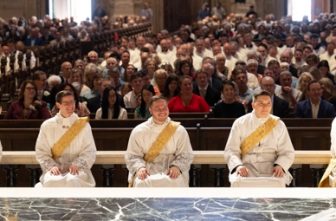 Bruce Richards, 55, is one of two Catholic school principals in the archdiocese who is now a deacon. He directs St. Joseph Catholic School in Waconia, while Deacon Mike McGinty — who was in Deacon Richards’ diaconate class and was also ordained last month — heads up Our Lady of Grace School in Edina.
Bruce Richards, 55, is one of two Catholic school principals in the archdiocese who is now a deacon. He directs St. Joseph Catholic School in Waconia, while Deacon Mike McGinty — who was in Deacon Richards’ diaconate class and was also ordained last month — heads up Our Lady of Grace School in Edina.
St. Joseph students are still adjusting to the fact that their principal now wears clerics and goes by “Deacon Bruce” rather than “Mr. Richards.”
He and his wife, Pat, live in Victoria and are parents of three 20-somethings.
Q) Tell me about your childhood, growing up outside Moorhead.
A) We had cows, chickens, pigs, horses and we raised our own crops of corn. We learned how to work hard and how to work together and how to be a family. Mass was always, always on our schedule. We belonged to a small parish, where we all served. With a family of nine, we took up more than a pew. It was great.
My mom created a Bored Basket. She said, “If you’re ever bored, come on in and grab a slip of paper out of this Bored Basket.” Well, it only took once to grab a slip and realize: You just chose a chore that’s going to take you three hours.
Boredom wasn’t an option. There was always a lot to do. It taught me to be creative and come up with my own things to do.
Q) You’ve been the St. Joseph principal for 11 years. What makes a good leader?
A) I keep saying I want to change the title on my door from principal to Dream Manager because a leader needs to have an eye out for the future and then have ways to get others to believe in the dream and then set up things to make it happen and then get out of the way and let the people do the good work.
Every morning at the end of our announcements, I say, “Take a step closer to heaven and don’t go alone.” That’s my way of living, and it’s become our school motto now. I can start the statement, and the kids finish it.
We really have to protect our culture and how we talk amongst ourselves because this is a holy place. It’s natural as humans to have frustrations. But if you just have to vent, take it to somebody that’s not at school. We have to maintain a positive culture and be as holy as we can, and that’s where prayer comes in. We can’t give to others what we don’t have.
We’re currently doing a Dynamic Catholic program using “Holy Moments” by Matthew Kelly. There’s a lot in there about hope. How do you create holy moments and make yourself available to God, setting aside self-interest you may have? Even if you do just a moment a day — oh my gosh, it has a powerful impact!
Q) What do you love about Catholic schools?
A) It’s the children and the families. When I hear the children sing at Mass — oh my gosh! It’s just angelic. Everyone who chooses to be here wants something good and holy. They want excellence and they’re willing to support it, and that’s beautiful. I appreciate the ability to pray together and openly and grow together.
Q) And praying can help kids keep anxiety at bay.
A) Absolutely. It brings peace of mind. If a kid comes in for a behavioral issue, I remind them right away: “This is a teaching moment. We’re going to process what happened and try to figure out why it happened. What are some of the triggers?” I want them to learn from those moments and remind them that we’re all human, we all make mistakes.
Q) St. Joseph was one of the first three schools in the archdiocese to get a STEM certification from St. Catherine University in St. Paul in 2015.
A) All our teachers got a graduate certificate through St. Kate’s. We did a lot of work. During the school year, we spent one night a week going to school. They came here. It was awesome because we were all learning together. We completed it in the summer. It took about 12 months total.
We’re also one of only two schools in the northern U.S. to get certified through the National Institute for STEM Education. Now we’ve been at it long enough that it’s who we are and how we do business. STEM is fun, it’s hands-on. It’s collaborative and creative. We do value-added projects. For example, the first graders study ornithology in art class, science, reading and language arts. We’re pulling all these learning categories together in an interesting way, and they make bird masks and do reports. We also try to bring in experts in the field.
I’ve got this picture in my office of Joseph the carpenter, and Jesus is playing with his tools on the floor, and it’s like: “OK! Jesus is being creative, and Joseph has his watchful eye above him. He’s making things.” I’ve always been driven to be creative. If I’m bogged down by administrative duties, I get a little grumpy.
Q) What’s it like being a deacon?
A) I feel like I’m walking in a bubble of grace, almost like a blanket. It’s a totally different emotional impact. It’s been amazing. I’m able to take things as they come: breathing it in, letting it go through your lungs and saying, “OK, this is life, let’s go.” It’s an attitude of peace.
Q) You’d felt called to be a deacon for more than 20 years. What made you finally act on it?
A) When I was first feeling this call, my kids were 1, 3 and 5. Then I started working in the Catholic schools again, and that was a huge surge to go deeper in my faith. And then it was a retreat experience. Afterwards, I thought: Now what? What’s the next right answer? I looked into the diaconate again and it was all systems forward since then.
Q) How is preaching different from teaching?
A) There’s not a huge distinction. I had three chances to preach in my first month. It’s still new. The difference is prep. We were taught (in diaconate formation) to sit and pray through the readings well in advance. It’s not, “What do I want to say about this, but rather, what message can I share to help the people here?” That takes more work.
Q) Are you a better principal because you’re a deacon — and vice versa?
A) I hope it’s both, absolutely. I’m trying to be a holy leader. Those who have been given more, there’s more expected. I feel like I’ve been given more so there are higher expectations. But through the grace of God, it’s beautiful.
Q) How do you keep a child-like faith?
A) Imaginative prayer. It’s Ignatian. Putting yourself as a person in the scriptural story.
Q) What do you do for fun?
A) We’re RVers. We’ve been coast to coast — to almost 40 states. We have an Itasca Sun Cruiser that we call Nelson for when the Twins had Nelson Cruz. All I have to do is sit in that chair and it’s like, “Ahh!” There’s a sense of leaving the stressors of daily life behind. I can even be sitting in the driveway.
Q) Do you ever go in it just to sit?
A) Oh for sure!
Q) What do you know for sure?
A) Heaven is for real. God loves us. He wants a beautiful relationship with us, and he’s waiting, a father with open arms.




